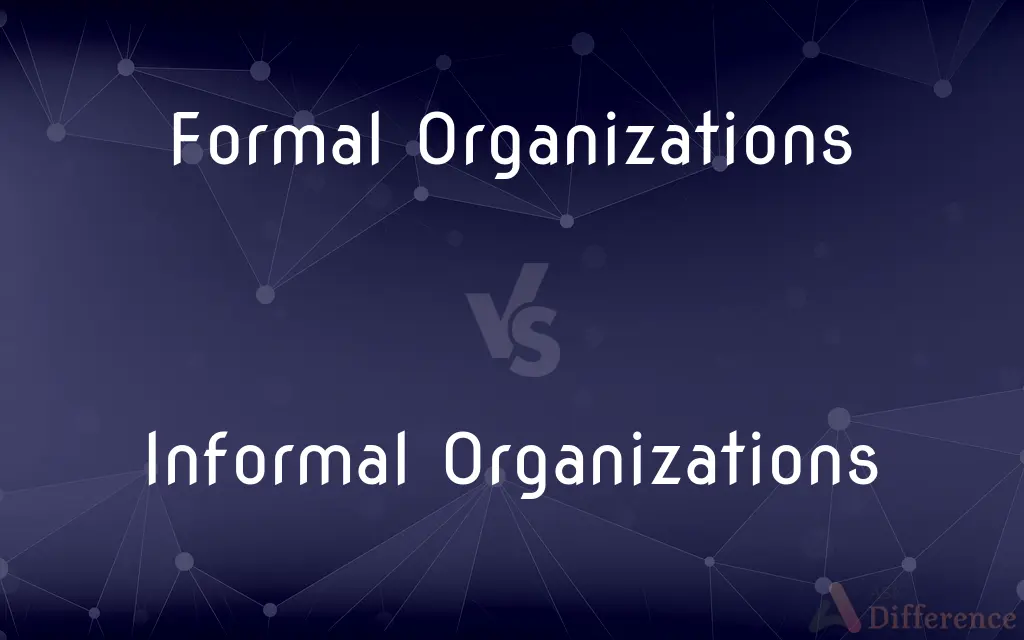Formal Organizations vs. Informal Organizations — What's the Difference?
By Tayyaba Rehman — Published on November 1, 2023
Formal organizations follow strict rules and have a clear structure, while informal organizations are based on personal relationships and lack fixed procedures.

Difference Between Formal Organizations and Informal Organizations
Table of Contents
ADVERTISEMENT
Key Differences
Formal organizations operate on structured and predefined rules and procedures. Informal organizations flourish on interpersonal relationships and personal connections, often emerging naturally among people.
In formal organizations, roles and responsibilities are defined clearly to each member. Informal organizations, on the other hand, do not have such clear-cut roles or hierarchy and function more on a personal and ad-hoc basis.
Formal organizations emphasize a hierarchy, where authority flows from top management down to the employees. Informal organizations involve more horizontal communication and decision-making processes, often without a clear authority structure.
Formal organizations necessitate official communication channels and documentation. Contrastingly, informal organizations allow for casual communication, and decisions can be made without extensive documentation.
Formal organizations often prioritize achieving organizational goals and objectives. Conversely, informal organizations might prioritize group or individual needs and could potentially counteract the formal organizational objectives.
ADVERTISEMENT
Comparison Chart
Nature
Structured and rule-oriented
Unstructured and relationship-oriented
Communication
Official channels and documented
Casual and undocumented
Hierarchy
Defined hierarchy and authority
Undefined hierarchy, equal status
Goal Orientation
Aim to achieve organizational objectives
Focus on individual or group needs
Flexibility
Less flexible due to rules and procedures
More flexible and adaptable
Compare with Definitions
Formal Organizations
Formal organizations have explicit goals and a defined hierarchy.
Universities, as formal organizations, have structured hierarchies and goals.
Informal Organizations
Informal organizations lack systematic rules and procedures.
A neighborhood book club is an instance of informal organizations.
Formal Organizations
Formal organizations possess intentional and systematic mechanisms of operation.
Military units, exemplary formal organizations, operate under stringent systems.
Informal Organizations
Informal organizations dynamically adapt and evolve based on member interactions.
An online gaming community is a malleable informal organization.
Formal Organizations
Formal organizations are entities with established rules and structures.
Corporations are typical examples of formal organizations.
Informal Organizations
Informal organizations don't have a defined hierarchical structure.
A casual sports team exemplifies the lack of hierarchy in informal organizations.
Formal Organizations
Formal organizations enforce clear communication channels and procedures.
Government agencies, as formal organizations, insist on documented communications.
Informal Organizations
Informal organizations arise from social interactions and relationships.
Friend groups at work often transform into informal organizations.
Formal Organizations
Formal organizations delineate roles and responsibilities clearly.
Hospitals define roles meticulously, characteristic of formal organizations.
Informal Organizations
Informal organizations prioritize personal connections and communications.
A group of freelancers collaborating is a typical informal organization.
Common Curiosities
What is the fundamental distinction between formal and informal organizations?
Formal organizations are rule-bound and structured, whereas informal ones are relationship-driven and unstructured.
How is communication handled differently in formal and informal organizations?
Formal organizations utilize official channels, while informal ones allow casual communication.
How do hierarchies in formal and informal organizations differ?
Formal organizations have defined hierarchies, while informal ones often lack clear authority structures.
What represents an example of a formal organization?
A government body or corporation exemplifies a formal organization.
What is a potential disadvantage of formal organizations?
They can be rigid and resistant to rapid changes.
Can you give an example of an informal organization?
A group of friends forming a hiking club is an informal organization.
How does leadership differ between formal and informal organizations?
Leadership in formal organizations is designated, while it may arise naturally in informal ones.
Can an organization be both formal and informal?
Yes, formal organizations can have informal networks or groups within them.
Can informal organizations exist within formal organizations?
Yes, informal organizations can naturally develop within formal ones, like friendship groups within a company.
Are informal organizations important in a corporate setting?
Yes, they can influence team dynamics, communication, and overall corporate culture.
Can informal organizations present disadvantages?
Yes, they might foster favoritism and create segregated groups.
How do formal and informal organizations impact employee behavior?
Formal organizations influence through rules; informal ones through social connections and norms.
How does decision-making differ in formal and informal organizations?
Formal organizations make decisions through established processes, while informal ones may decide more collaboratively and casually.
Do formal organizations always have physical structures?
No, they can exist and operate virtually but maintain formal structures and rules.
Are all casual groups informal organizations?
Not necessarily, but any group operating without structured rules can be considered informal.
Share Your Discovery

Previous Comparison
Amazon Prime vs. Prime Video
Next Comparison
Cytokines vs. ChemokinesAuthor Spotlight
Written by
Tayyaba RehmanTayyaba Rehman is a distinguished writer, currently serving as a primary contributor to askdifference.com. As a researcher in semantics and etymology, Tayyaba's passion for the complexity of languages and their distinctions has found a perfect home on the platform. Tayyaba delves into the intricacies of language, distinguishing between commonly confused words and phrases, thereby providing clarity for readers worldwide.
















































